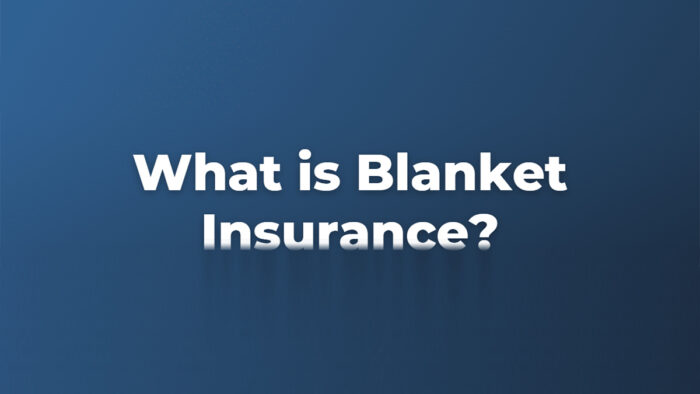Blanket insurance is property insurance that offers protection for more than a single property at the same location or multiple locations. It is an ideal option for individuals who seek to protect their businesses and personal properties against certain perils and financial ruin.

Homeowners insurance is a type of blanket insurance that covers the structure and content of your property and business space. If you are a landowner with different buildings in different locations, we strongly advise you to get a blanket policy.
What Does Blanket Insurance Cover?
Typically, blanket insurance covers everything outlined in your policy. This means that the amount of coverage largely depends on the specific blanket policy you purchase.
However, we have helped to curate examples of what a typical blanket policy will cover, such as:
- Personal properties, which include clothes, jewelry, business equipment, and other related personal belongings.
- Building and the home appliances and belongings contained in the building, such as clothes and furniture.
- If you own multiple properties, it will cover certain risk exposures.
- It also covers common areas that are commonly shared by members of a condo association or homeowners association.
These are the basic things covered under a blanket policy. However, it is important to know that the level of coverage is based on the type of insurance policy you are purchasing. So, if you are getting this insurance policy, ensure you purchase sufficient coverage for yourself.
Who Needs Blanket Insurance?
If you own multiple properties and seek coverage for certain types of peril, you should consider getting a blanket policy.
Blanket insurance offers protection for your properties and business in different locations, be it residential, commercial, or rental. Economically, we advise individuals to purchase individual policies; you can also add riders if they are necessary.
How Much Does Blanket Insurance Cost?
Typically, the price of a blanket policy depends on a variety of factors, so we can’t specifically say this is the actual price; it varies. What you need to do is assess your needs to determine the specific type of coverage that best suits you.
Once you’ve decided on the type of policy you want, get in touch with your insurance provider; they are in the best position to tell you the price it would cost to get blanket insurance. Remember, the cost will be calculated based on the type of coverage you seek and any other related fees specified by your insurance provider.
Advantages of Blanket Insurance
Blanket insurance offers a variety of benefits to policyholders. If you intend on purchasing blanket insurance, here are some of the benefits you get to enjoy:
- Flexibility: It is so flexible that it allows you to add or remove property at any time from your insurance policy. You can also increase or decrease coverage with ease instead of purchasing a new type of policy.
- Cost-effective: Although the price of blanket insurance is on the high side, you can still cut prices if you are insuring several properties covered by one policy. You can negotiate the terms and price with your insurance provider to get the best option.
- Comprehensive Coverage: Compared to other types of insurance policies, blanket insurance offers more comprehensive coverage for business and property owners. For instance, it may provide coverage for multiple pieces of farm equipment that are not covered under other types of policies, such as homeowners insurance.
- Catastrophe Protection: Also, a blanket policy offers protection in the event of a catastrophic event that causes damage to several properties. With this insurance, you have optimal protection.
Disadvantages of Blanket Insurance
While blanket insurance offers numerous benefits to policyholders, it is important to review its downsides as well. Outlined below are some its disadvantages:
- Inadequate Coverage: Most blanket insurance does not cover certain perils, such as damages caused by flooding. The only way your blanket insurance coverage can be sufficient for you is if the insured properties are updated and added properly to your policy.
- Less Value: In a blanket policy, there is an underestimation of value. If the dwelling and property to be insured are not properly assessed for value, the policy may offer low-quality coverage. Usually, a homeowner’s insurance policy places value on replacement costs, which ultimately ensures a sufficient amount of coverage.
- Complex in Nature: When it comes to filing claims, it is often difficult for policyholders, especially for those who wish to file claims on multiple terms. For each claim, there is a different process, meaning that your claims would be processed separately.
- Higher Premiums: If you are purchasing a blanket policy, be prepared for the premiums that come with maintaining your policy. The reason it comes with a higher premium is because of the type of coverage it offers.
In addition, there are policy exclusions and limitations in blanket policies. Although it offers comprehensive coverage, there are certain perils it does not cover. The most important thing to do is to weigh your options and decide whether obtaining blanket insurance is an ideal option for you.
While a blanket policy is most suitable for individuals who own a business or multiple properties, it is not an ideal option for a single business location, family home, or apartment.
How To Get Blanket Insurance
To secure a blanket policy, you can follow the steps below:
• Evaluate your insurance requirements
Review your circumstances to determine if a blanket policy aligns with your needs. A blanket policy could be advantageous if you own multiple rental properties, businesses, equipment, or assets at home that aren’t protected by your homeowner’s policy. Nevertheless, it’s important to accurately assess the worth of your residence and belongings to obtain an exact quote.
• Explore insurance companies
Not all insurers offer blanket policies, so focus your search on those that do. Furthermore, explore the companies for qualities such as stability, claim processing efficiency, and customer service ratings.
• Collect essential information
When requesting a quote, the insurance company will require various types of information, including personal details, property and belongings, the policies needed, and other data. Having this information readily available will expedite the process and enhance the accuracy of the quote.
• Compare quotes and coverage
Upon receiving your quotes, carefully assess each to determine the best option. However, it’s important to consider factors like premiums, coverage amounts, deductibles, limitations, and exclusions when making your decision.
• Review your policy
After the insurance company completes and submits an application, the underwriting department will assess it and may ask additional follow-up questions. Once the policy is approved, it’s essential to thoroughly review it to confirm that it aligns with your expectations.
• Submit the premium payment
Typically, an insurance provider only activates coverage for a blanket policy once the policy has been approved and the premium paid. Therefore, it’s important to make the first premium payment promptly to guarantee coverage.
• Lastly, keep accurate records
After the policy takes effect, it’s essential to maintain records of any improvements and equipment purchases.
Some policies may necessitate contacting the insurer within a specific timeframe, typically thirty days, to add, remove, or modify coverage or covered items.



